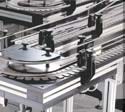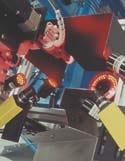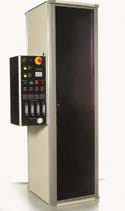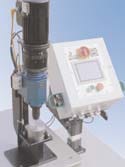Assembly and Automation
April 7, 2004
Originally Published MPMNApril 2004
SPOTLIGHT
Assembly and Automation
Automated cleaning equipment
 High-performance cleaning equipment is suitable for parts with complex geometries, as it produces enough power to penetrate blind holes and hidden areas. Processing takes place within a controlled environment to help prevent recontamination. The units offer full automation and can clean metal, plastic, silicone rubber, and glass. Product configurations include aqueous systems with spray, ultrasonic systems, and combination systems with low to high throughputs.Entegris Inc., Chaska, MN www.entegris.com
High-performance cleaning equipment is suitable for parts with complex geometries, as it produces enough power to penetrate blind holes and hidden areas. Processing takes place within a controlled environment to help prevent recontamination. The units offer full automation and can clean metal, plastic, silicone rubber, and glass. Product configurations include aqueous systems with spray, ultrasonic systems, and combination systems with low to high throughputs.Entegris Inc., Chaska, MN www.entegris.com
Assembly and testing machines
 Two- and three-part syringes, IV components, and devices for automated laboratory analysis can be processed on assembly and testing machines. Suitable for cleanroom applications from Class 100,000 to Class 1000, the equipment is offered in stainless steel and designed for easy access and disinfection. Up to 65 stations can be integrated into a single compact system for feeding, assembly, printing, labeling, leak testing, and measuring of various parameters.
Two- and three-part syringes, IV components, and devices for automated laboratory analysis can be processed on assembly and testing machines. Suitable for cleanroom applications from Class 100,000 to Class 1000, the equipment is offered in stainless steel and designed for easy access and disinfection. Up to 65 stations can be integrated into a single compact system for feeding, assembly, printing, labeling, leak testing, and measuring of various parameters.
Mueller + Kurtz Sondermaschinen GmbH, Winterbach, Germany www.mueller-kurtz.com
Chain conveyors
 Systems of flat-top and tabletop chain conveyors meet applications in high-volume product handling. Modular subassemblies include drive units, straight tracks, and curves for system assemblies of various lengths or layouts. Systems are configured using precision aluminum profile frames and full-length f-slots for assembling components such as side frames, drive units, supports, and guide rails. Flat-top chain choices include carbon or stainless steel and thermoplastic, in industry widths including 31¼4, 4, 41¼2, 6, 71¼2, 10, and 12 in. Conveyor choices include all plastic, all steel, and roller chain with snap-on flights in straight running or side-bow and side-flex types.mk Automation Inc., Bloomfield, CT www.mkprofiles.com
Systems of flat-top and tabletop chain conveyors meet applications in high-volume product handling. Modular subassemblies include drive units, straight tracks, and curves for system assemblies of various lengths or layouts. Systems are configured using precision aluminum profile frames and full-length f-slots for assembling components such as side frames, drive units, supports, and guide rails. Flat-top chain choices include carbon or stainless steel and thermoplastic, in industry widths including 31¼4, 4, 41¼2, 6, 71¼2, 10, and 12 in. Conveyor choices include all plastic, all steel, and roller chain with snap-on flights in straight running or side-bow and side-flex types.mk Automation Inc., Bloomfield, CT www.mkprofiles.com
Vision inspection system
A multiple-camera vision inspection system performs mold cavity inspection and is suitable for medical injection molding applications. Integrating a graphical user interface, the Raptor vision system is set up and programmed without redundant controls and monitors. The equipment checks critical dimensional variances, surface finish, ID and OD tolerances, part lengths, and insert molding part presence and positions. A robot and workcell controller enable plastics processors to verify part quality, reduce waste, and maximize efficiencies at the point of manufacturing. Available options include infrared LED spotlights, backlights, and lenses for cameras from 6 to 75 mm, plus filters and extension tubes.
Automated Assemblies Corp., Clinton, MA www.aac-robot.com
Tube-laminating system An automated machine laminates heat-shrinkable polymer tubing onto a catheter shaft. Tube laminating, or shrinking, is a technique used by medical device engineers in the catheter-manufacturing process. The VS810A handles up to four catheter shafts--with lengths up to 71 in.--simultaneously. The machine also automates the process of traversing a focused and uniform hot-air stream along the length of the tubing to be laminated. Using an operator keypad, the system enables a range of traverse lengths and speed settings. Additional features include tubing guides to center the product within the heat zone. Independent temperature control of each item for consistency eliminates variances associated with manual and industrial oven techniques.Beahm Designs, Campbell, CA www.beahmdesigns.com
An automated machine laminates heat-shrinkable polymer tubing onto a catheter shaft. Tube laminating, or shrinking, is a technique used by medical device engineers in the catheter-manufacturing process. The VS810A handles up to four catheter shafts--with lengths up to 71 in.--simultaneously. The machine also automates the process of traversing a focused and uniform hot-air stream along the length of the tubing to be laminated. Using an operator keypad, the system enables a range of traverse lengths and speed settings. Additional features include tubing guides to center the product within the heat zone. Independent temperature control of each item for consistency eliminates variances associated with manual and industrial oven techniques.Beahm Designs, Campbell, CA www.beahmdesigns.com
Process monitoring and control
 A monitoring and control system ensures consistency and uniformity of orbital formed rivets. The WatchDawg system monitors rivet and form collapse and length through set point limits. Users can access information on how much of the rivet has been formed and whether the load-cell trigger point has been met. The system has the ability to produce parts with diameters from 0.06 to 2 in., and offers pressure-differential process controlto form parts to a prescribed clamp load. A load cell is mounted inside the powerheadof the spindle assembly to measure the forming force applied to a part. Depending on the machine size, a linear displacement transducer or linear encoder is integrated into the powerhead to measure stroke.The machine's interface provides comprehensive feedback with data integrated into an automated system. Multiple programs can be stored toallow for quick changeover from one application to another. Orbitform, Jackson, MIwww.orbitform.com
A monitoring and control system ensures consistency and uniformity of orbital formed rivets. The WatchDawg system monitors rivet and form collapse and length through set point limits. Users can access information on how much of the rivet has been formed and whether the load-cell trigger point has been met. The system has the ability to produce parts with diameters from 0.06 to 2 in., and offers pressure-differential process controlto form parts to a prescribed clamp load. A load cell is mounted inside the powerheadof the spindle assembly to measure the forming force applied to a part. Depending on the machine size, a linear displacement transducer or linear encoder is integrated into the powerhead to measure stroke.The machine's interface provides comprehensive feedback with data integrated into an automated system. Multiple programs can be stored toallow for quick changeover from one application to another. Orbitform, Jackson, MIwww.orbitform.com
 Monorail transport system
Monorail transport system
Built to transport materials, self-propelled shuttles are specially designed with preset acceleration and deceleration ramps and optical sensors. The Montrac system ensures gradual acceleration, shock-free transport, and smooth braking for electrically driven shuttles. Sensitive products and liquids can be moved and handled by the system, and Montrac meets the criteria for cleanroom conditions.Montech LLC, Huntersville, NC www.montech-usa.com
 Bidirectional transport platform
Bidirectional transport platform
A transport system offers integrators and manufacturers a collection of predesigned modules for practical reconfiguration, expandability, and flexibility for future changes. In addition to automated transportation, the SmartAutoMotion (SAM) platform enables production flow management for nonserial operations with full traceability. The equipment begins with the company's Smart pallet, a transport system with below-surface one-, two-, or three-axis motion and onboard controls. With programmability, bidirectional travel, speed, and accessories, the transport pallet can change paths with maximum flexibility. Two product lines of SAM components are available. MicroMega is suitable for coil-winding automation applications, and Expandia is used for general-purpose automation. Both options are based on standardized components, including rail systems, precision multiaxis pallets, enclosures, control systems, and pick-and-place mechanisms.Marsilli North America, Owings Mills, MD www.marsillina.com
 Catheter-forming systems
Catheter-forming systems
A provider of precision instruments offers systems designed to heat and form thermoplastics into finished catheters. The PIRF generators can be combined witha variety of tipping, welding, and forming molds for additional capabilities. PIRF controls the temperature to 1°C and monitors the flow of plastic for a variety of materials, sizes, and forming dimensions. PIRF II is designed to form complex, small-profile catheters by concentrating heat in bands of less than 1 mm. The heat placement produces tips with smooth surface finishes and strong welds. PIRF III features power for multiple-part tipping
for operator efficiency in forming large-profile catheters. The system also includes temperature monitoring with high and low alarms, front-panel programming, and quick-release mold and gripping assemblies.Sebra, Tucson, AZ www.sebra.com
 Cartesian motion system
Cartesian motion system
Using preconfigured robots, a Cartesian motion system (CMS) helps integrators, OEMs, and end-users reduce the time required to specify designs and install multiaxis systems. The CMS features up to three axes and is designed for payloads up to 25 kg, speeds up to 1.0 m/sec, and acceleration rates up to 15 m/sec2. Depending on the chosen axis combination and size, the equipment can execute strokes up to 1000 mm in the x-axis, 700 mm in the y-axis, and 800 mm in the z-axis. The range of motion provided makes the system suitable for pick-and-place applications in assembly cells, at transfer stations, and in packaging and handling.Bosch Rexroth Corp., Hoffman Estates, IL www.boschrexroth-us.com
Copyright ©2004 Medical Product Manufacturing News
You May Also Like

.png?width=300&auto=webp&quality=80&disable=upscale)
